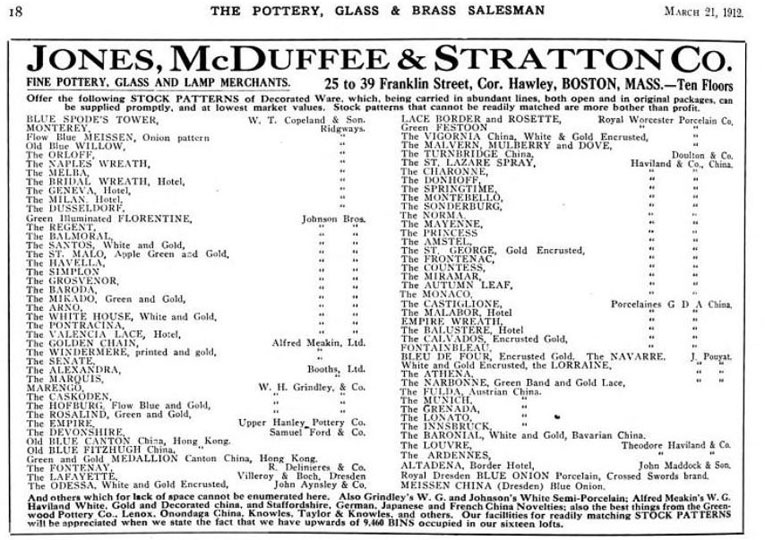| Haviland Limoges Pattern - The Monaco |
| David Haviland and his brothers sold imported English cream ware and Staffordshire in New York from about 1821. Their company was called Haviland Brothers & Company. Then David was introduced to porcelain from the Limoges region of France. David moved to France in 1842. In 1847 he opened a decorating shop to decorate porcelain in patterns acceptable to the American market and then exported them to America through the brothers' company in New York. By 1855 he was producing porcelain in France.
With the outbreak of the Civil War in the U.S., the brothers had to shut down Haviland Brothers & Company as the south represented a large market for their porcelain. David formed a new Company, in France, called Haviland & Company and brought his two sons, Charles Edward and Theodore, into the business. After the Civil War, Theodore moved to the US to oversee importing and marketing while Charles Edward took over the operations in Limoges. David passed away in 1879.
In 1891, the brothers, Charles Edward and Theodore, went their separate ways. David retained the Haviland & Company name and Theodore opened a new company called Theodore Haviland Company. The 1890s through 1920s was a great time for the import of French porcelain to the US and over 30,000 patterns were developed by various makers.
In 1926 a large fire destroyed many of the warehouses and the designing room of Haviland & Company and in September 1929 a fire destroyed the contents of the Haviland museum and other warehouses. With the Great Depression hitting just a month later, Haviland and Company closed its doors in 1931. Theodore Haviland survived WW1, the Great Depression and WWII. In 1941 they bought all the rights and trademarks to Haviland & Company thus bringing the two companies back to one. From 1936 to 1957, Theodore Haviland produced porcelain in New Castle PA. In 1972 all Haviland family members had retired from the business.
The pattern shown below is called "The Monaco". It is decorated with transferware and thus the main design is not hand painted. The Monaco does have hand painted gold edges and the handles and finials are also typically painted in gold gliding. The spouts on some pots are hand painted with gold scroll work. Overall, transferware is a less expensive form of decoration and would have made the pattern more affordable to the American mass markets. Transferware is a pattern printed on tissue that is laid out on the porcelain and then glazed over and fired. Please note the marks on the backs of these pieces as shown at the bottom. The Monaco pieces are typically made on Haviland's "Smooth Blank". Haviland produced many designs right in the porcelain and these were often raised designs around the edges. The Smooth Blank is just that, the porcelain is smooth without raised designs. Smooth blank pieces come with a distinctive pointed handle. Some Monaco pieces have designs in the porcelain, particularly the handles on some bowls and platters. |
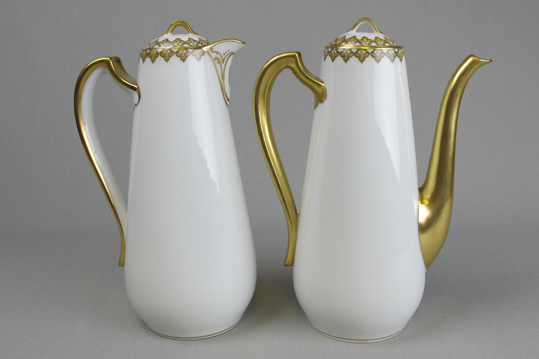 |
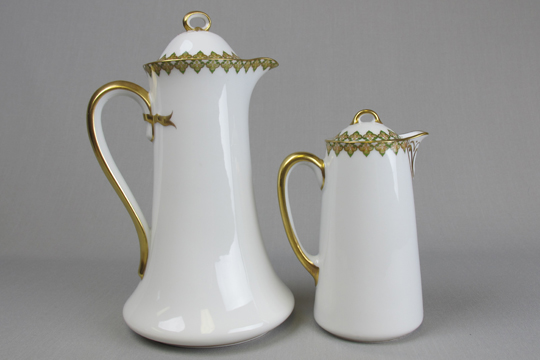 |
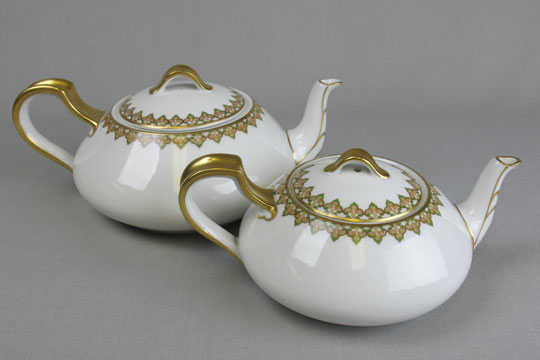 |
| These two pots are the same shape but their spouts are different. The spout at the top make the pot on the left a Chocolate Pot and the long spout coming from the bottom makes the pot on the right a Coffee Pot. Both pots are nine inches tall. |
Both of these pots are Chocolate Pots as they have a small spout at the top. The pot on the left, which is nine inches tall, has a ribbon in the porcelain going across the handle where it meets the upper portion of the pot. The smaller pot, 6 1/8 inches tall, would be an individual pot. |
These two pots are Tea Pots. Tea Pots are short and wide to give more room for the tea leaves to steep. Shown here are two sizes. One is 9 inches from spout to handle and the smaller one is 7 1/2 inches. |
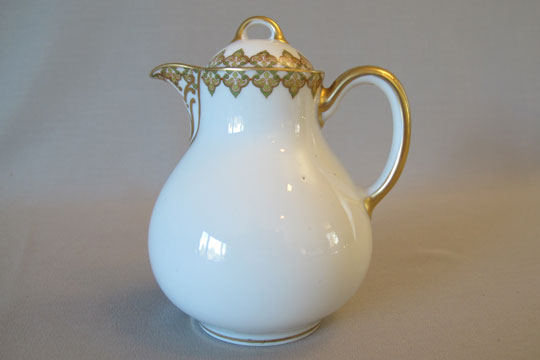 |
 |
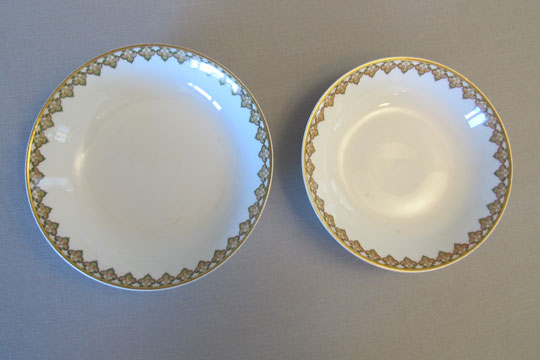 |
| This is a lidded syrup and a right angle handled coffee pot. The syrup is 4 3/4 inches tall and the coffee pot is 7 inches tall. Notice that the syrup pot spout is decorated with both transferware and gold scrollwork. Typically, a spout would have one or the other. |
This nest of plates include; from largest to smallest; a dinner plate at 9 3/4 inches, a luncheon plate at 8 3/4 inches, a salad plate at 7 5/8 inches, and a bread and butter plate at 6 1/4 inches. These plates all have a rim to them.
|
These berry bowls come in two sizes; 5 5/8 or five inches across.
|
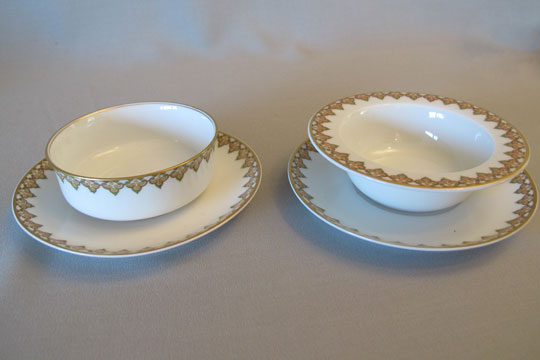 |
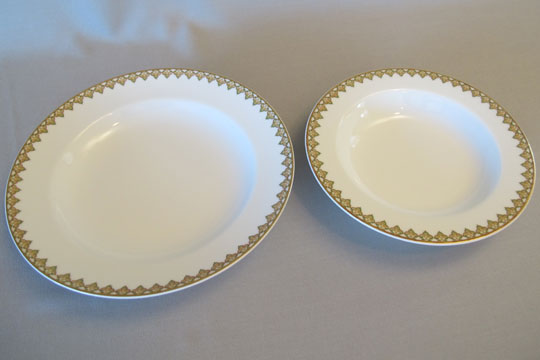 |
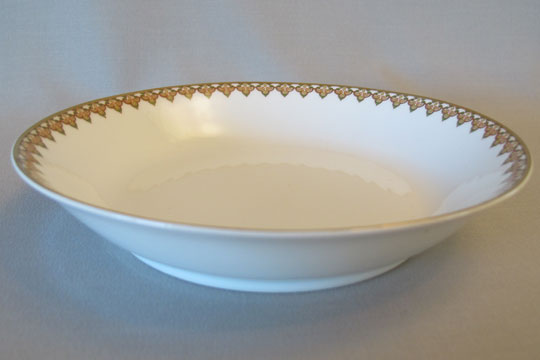 |
| These bowls are called ramekins and both come with under plates. The coupe ramekin, with the design on the outside, is 1 1/4 inches tall and 3 3/8 inches across the rim. The rimmed ramekin has the design on the inside and is 1 1/4 inches tall and 4 3/8 inches across the top. Both have unglazed bottoms. The under plates are 5 1/8 inches across and the insert is 2 1/4 inches across. The insert is larger than any cup saucer. |
These two pieces are soup bowls. The larger is nine inches across and the smaller standard size is 7 1/2 inches across. They are both rimmed. |
This is a coupe soup bowl and is 7 1/2 inches across.
|
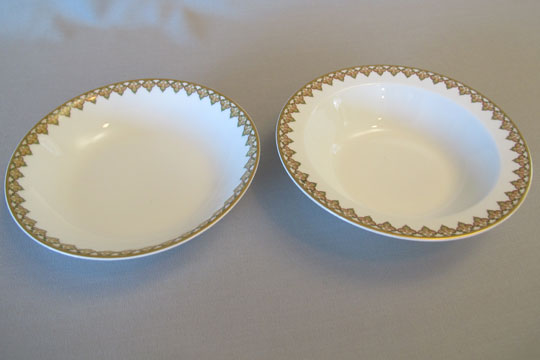 |
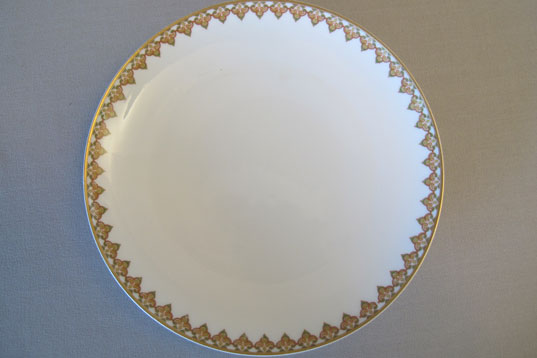 |
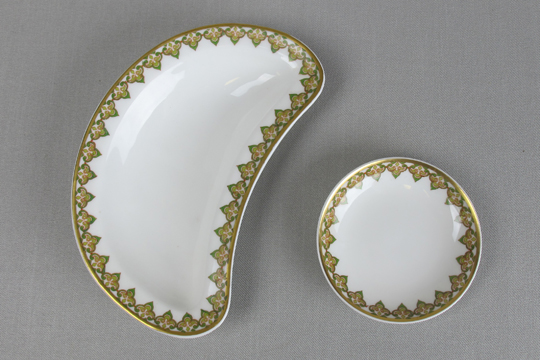 |
| These are cereal bowls. The one on the left is a coupe ceral bowl and is six inches across. The one on the right is a rimmed cereal bowl and is 6 3/8 inches across.
|
This is a coupe salad plate and is 7 5/8 inches across. It is much harder to find than the rimmed salad plate.
|
This photo shows a six inch bone dish and a three inch butter pat. |
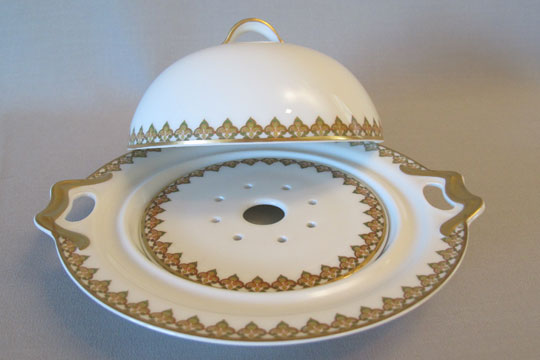 |
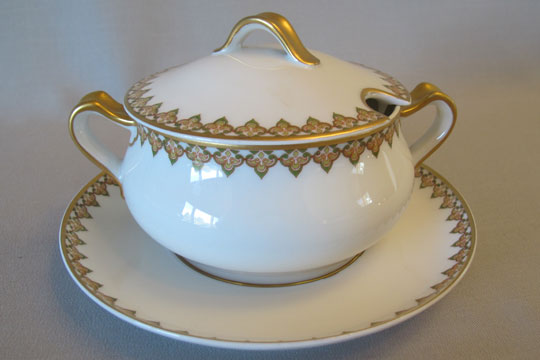 |
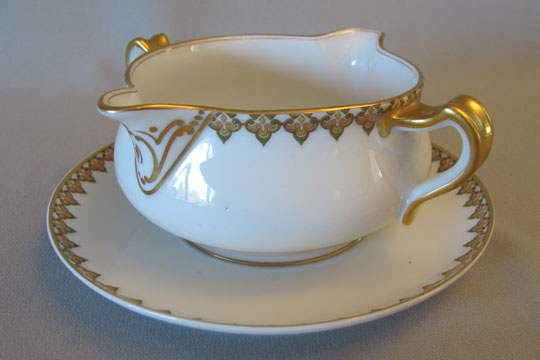 |
| This is a three piece butter dish and includes an underplate, a strainer (so your butter is not sitting in a pool of water), and a domed lid. The underplate is 8 1/4 inches across and the total height of the butter dish is 3 1/2 inches. |
This sauce boat has an attached underplate. It is 4 inches tall including the lid and the underplate is 6 3/4 inches across. There are two handles. The lid also has a handle and it has a slot for a ladle. |
This gravy boat has an attached underplate. It is 2 1/2 inches tall and the underplate is 6 3/4 inches across. There are two handles and on opposing sides, two spouts. |
 |
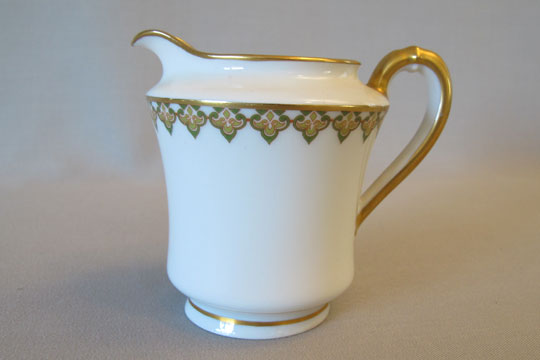 |
 |
| This is a two piece gravy boat, a gravy and an under plate. The under plate has an insert for the gravy boat. Both pieces are about 7 1/4 inches long. |
This creamer has a matching sugar. It has the round handle. It is 3 1/2 inches tall. |
This waste bowl or cranberry bowl is 2 5/8 inches tall and 5 1/2 inches across the rim.
|
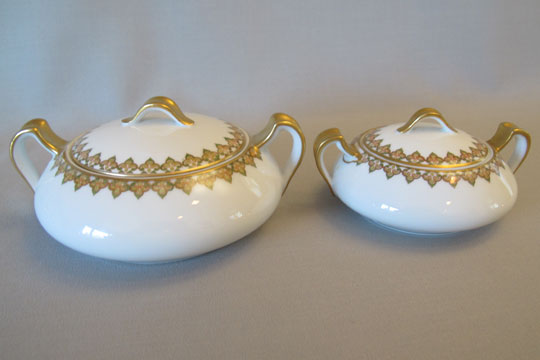 |
 |
 |
| Here are two sizes of covered sugars. The larger sugar is three inches tall including the lid and 6 1/4 inches across including the handles. The smaller sugar is 2 1/2 inches tall including the lid and 5 1/4 inches across including the handles. All four pieces, the lids and the bottoms, have the number "30453" in red on them. |
Here are two sizes of creamers. The larger creamer is 2 1/2 inches tall including the handle and 5 1/2 inches across including the handle. The smaller creamer is 2 1/8 inches tall including the handle and five inches across including the handle. |
These are an individual sugar and a individual creamer. The open sugar is two inches tall and four inches across the rim. The creamer is 2 3/4 inches tall and four inches across from spout to handle. |
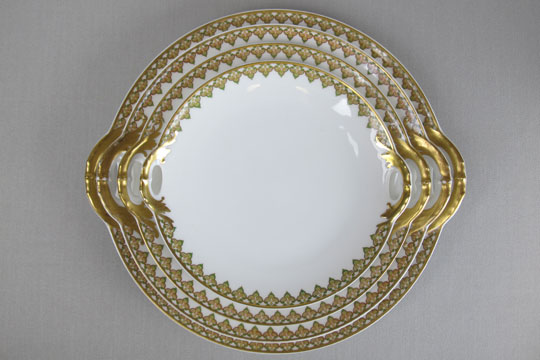 |
 |
 |
| These two handled bonbon or cake plates are 10 5/8 inches, 9 1/2 inches, 8 1/4 inches and 7 1/4 inches across including the handles. |
These single handled rimmed nappies are nine inches, 6 3/4 inches and 4 3/4 inches across including the handle. |
This single handled coupe nappy is 7 1/2 inches across including the handle. |
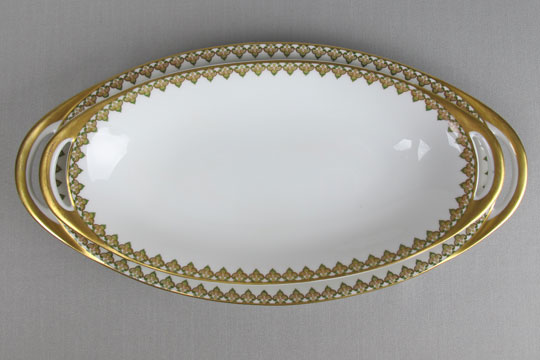 |
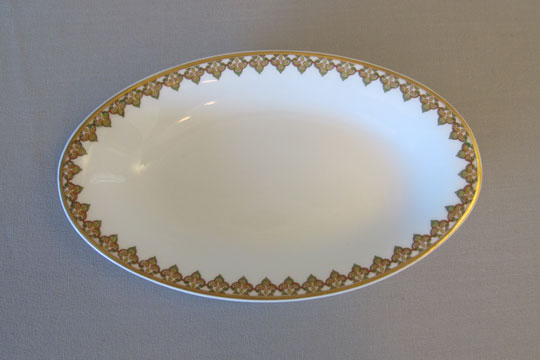 |
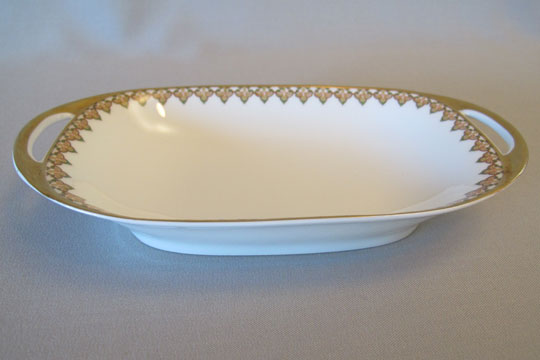 |
| Here are two sizes of celery trays. They are 12 and 14 inches long including the handles. |
This relish dish is eight inches long. |
This two handled relish dish is 8 1/2 inches long including the handles. |
 |
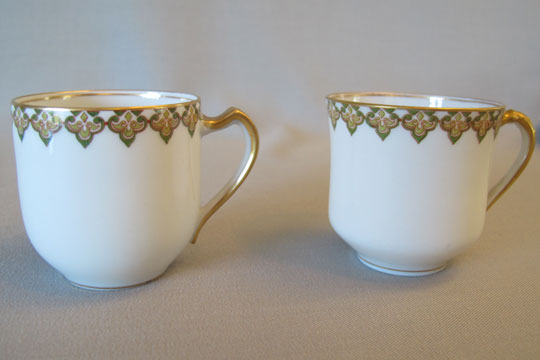 |
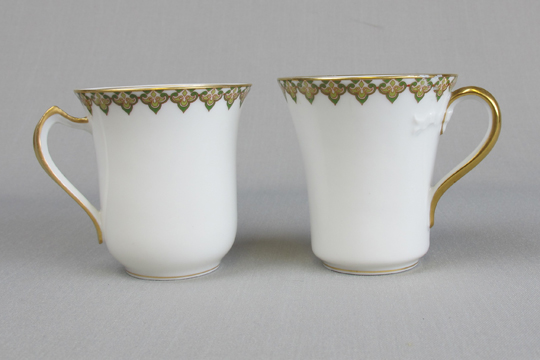 |
| This Five O'clock cup is 1 3/4 inches tall and three inches across the rim. It has a round handle. |
These demittasse cups are both 2 1/8 inches tall and 2 1/8 inches across the rim. The one on the left has a pointed handle and the one on the right has a round handle. |
These chocolate cups are both 2 7/8 inches tall and 2 3/4 inches across the rim. The one on the left has a pointed handle and the one on the right has a round handle. |
 |
 |
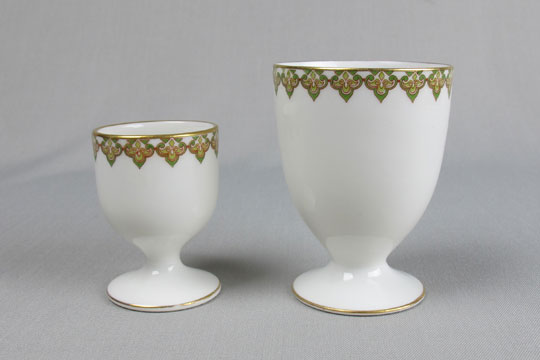 |
| These three cups; a coffee cup, a tea cup and a bouillon cup, are the three easiest to find. The coffee cup is 2 1/8 inches tall and 3 5/8 inches across the top rim without the handle. Both the tea cup and the bouillon cup are two inches tall and 3 1/4 inches across the top rim without handle or handles. All three have pointed handles. Some cups may have the design also on the inside. |
These four saucers were made for the various cups produced. The smallest at 4 3/8 inches across can have either an insert of 1 1/4 inches for a demitasse or 5 o'clock cup or an insert of 1 1/2 inches for a chocolate cup. The 4 7/8 inch saucer has an insert of 1 1/2 inches for a chocolate cup. The 5 1/4 inch saucer has an insert of 1 7/8 inches for a tea or bouillon cup. The 5 5/8 inch saucer has an insert of 1 7/8 inches for a coffee cup. |
Here are an egg cup and a double egg cup. An egg cup is made to hold a soft boiled egg so that it may be broken and the inside eaten with a spoon. A double egg cup does not hold an egg but a mixture of cooked egg, bread crumbs and assorted vegetables such as onions and peppers. This mixture is cooked on the stove, placed into the cup and then also eaten with a spoon. The egg cup is 2 3/8 inches tall and the double egg cup is 3 1/4 inches tall. |
 |
 |
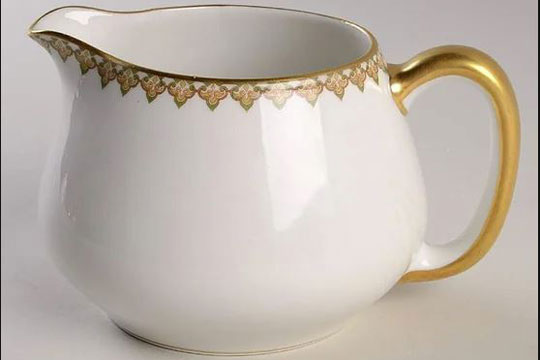 |
| This punch cup would have come in a set of twelve and accompanied a punch bowl with a large under plate. The punch cup is three inches tall and 3 3/4 inches across the top rim. |
These handled jugs are 9 1/2 inches, 7 3/4 inches and 6 1/4 inches tall. |
This small jug is four inches tall and it holds 28 ounces of liquid. The photo and information is courtesy of Replacements.com as I have never seen this piece. |
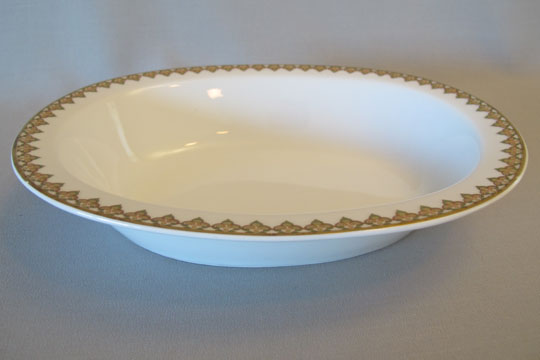 |
 |
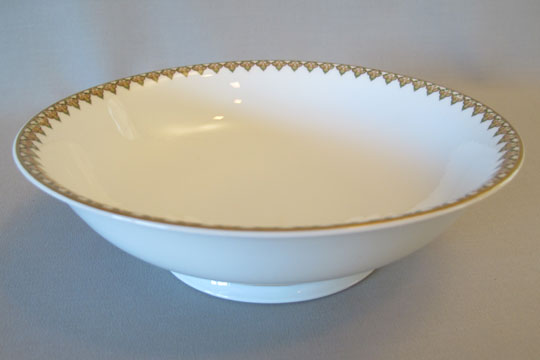 |
| This oval bowl is 10 inches across. It has a flat rimmed edge and the bottom is unglazed. |
This oval bowl is 10 inches across. It has a flared edge. |
This round open vegetable dish is 2 3/4 inches tall and nine inches across. |
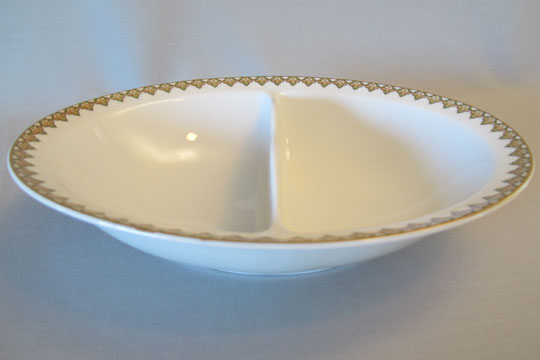 |
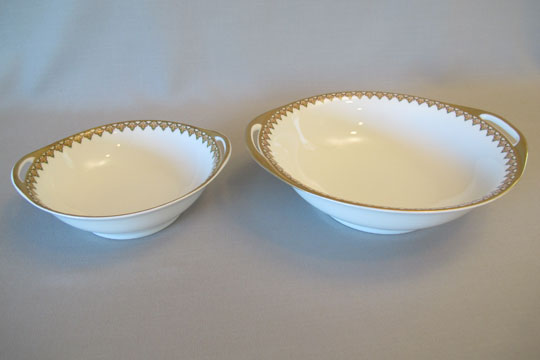 |
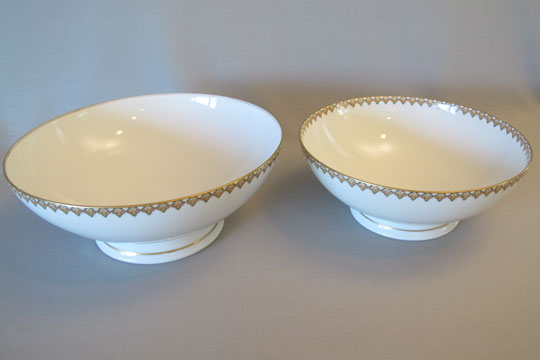 |
| This divided vegetable dish is 10 inches across. |
These two handled serving bowls are seven and nine inches across. A five inch bowl is also known. |
These salad bowls are nine and 10 1/4 inches across the top. Notice that the smaller bowl has the pattern on both the inside and the ouside. |
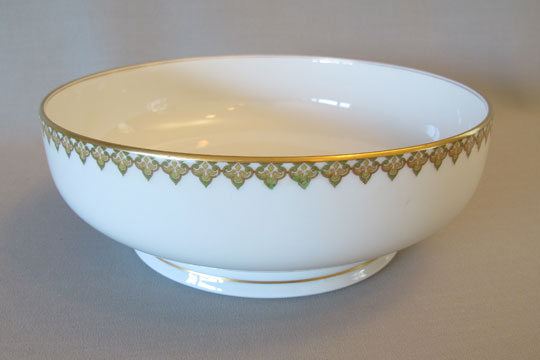 |
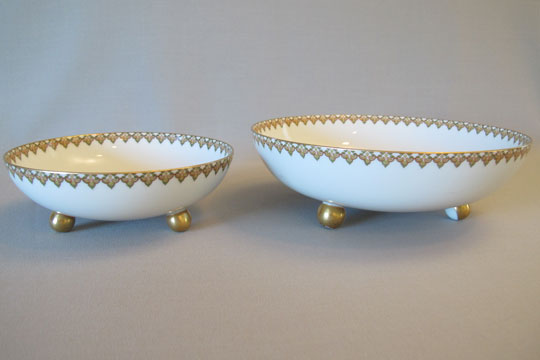 |
 |
| This bowl has sides that are straight up and thus the pattern is on the outside. It is 3 1/8 inches tall and 8 3/4 inches across the top rim. |
These bowls each have three ball feet. They are six and eight inches across the top rim. Notice that the decoration is on both the inside and the outside.
|
These two bowls have their four corners pinched in. The larger bowl is eight inches wide and 10 inches across. The smaller bowl is five inches wide and 6 1/4 inches across. |
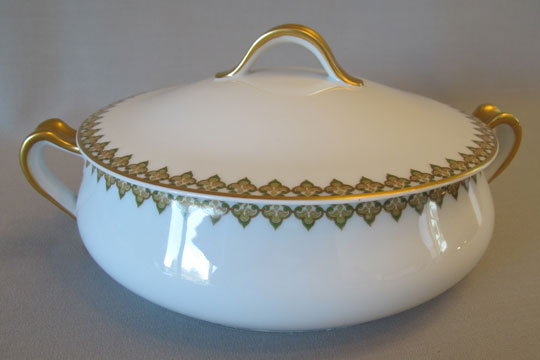 |
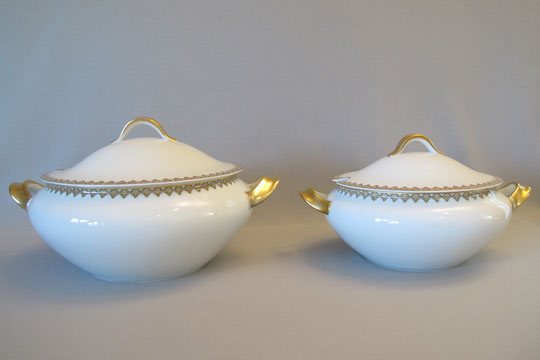 |
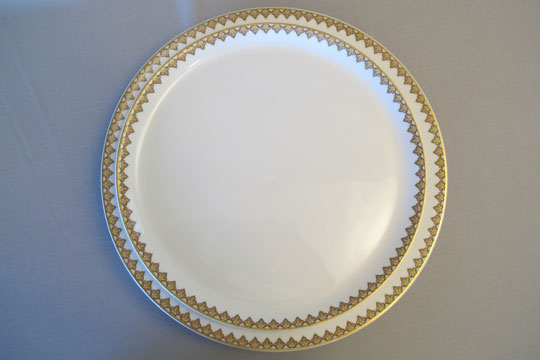 |
| This covered casserole dish is four inches tall including the lid and is 10 inches across including the two handles. This lid does not have a slot for a ladle. |
These are two soup tureens. The larger is seven inches tall and 13 inches across. The smaller is six inches tall and 11 inches across. Both measurements include the side handles and the lid. Both lids have a slot for a ladle.
|
These two large round platters are 12 3/4 inches across and 11 1/8 inches across. The smaller of the two has an unglazed bottom which allows it to be placed in an oven. The larger plate is called a chop plate and the smaller a torte plate. |
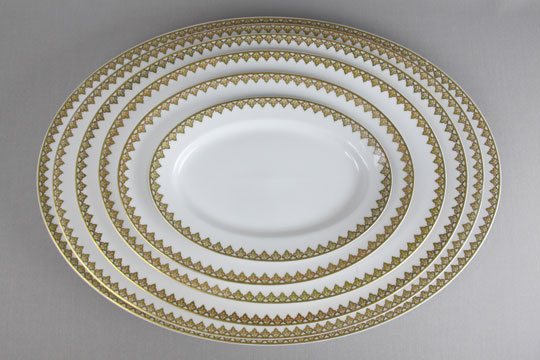 |
 |
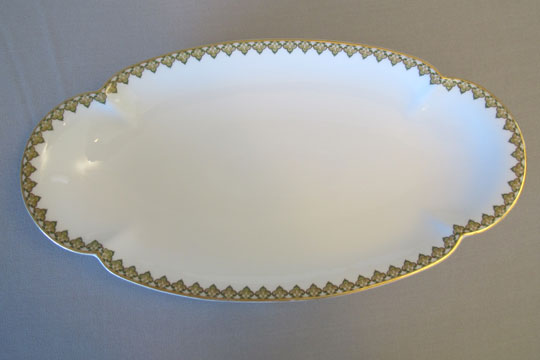 |
| These 6 platters are 20 inches, 18 1/8 inches, 16 1/8 inches, 13 3/4 inches, 11 3/4 inches, and nine inches across. The two largest platters have drip wells to gather the meat's drippings. An 18 inch fish platter is known. |
These three platters are 15 1/2 inches, 13 1/2 inches, and 11 1/2 inches across. The handles are formed in the porcelain and are raised and gilded and the four "corners" are pinched in. Bowls with these handles are known. |
This fish platter is 13 inches across. The four "corners" are pinched in. Fish platters are longer and less wide than a standard platter.
|
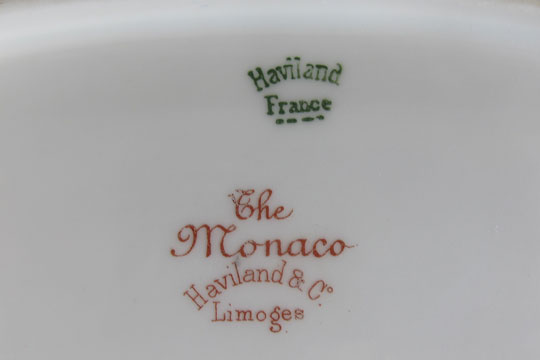 |
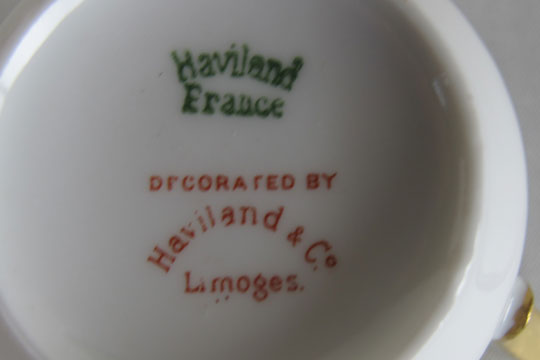 |

 |
| The three photos above show and describe the Haviland marks found on the bottom of most Monaco pieces. Pieces may have up to three marks on the bottom, a Maker's mark in green, a Decorator's mark in red and a pattern name also in red. The Maker's mark says "Haviland France" This was applied under the glaze and is thus fired on. The Decorator's mark says "Haviland & Co. Limoges". Thus pieces were decorated by Haviland. The mark is in red and is placed after the glaze is fired. This means that the red mark can be more easily scratched off than the green mark. Sometimes the Decorator's mark also includes the words "Decorated By" above it. The pattern mark, "The Monaco", is seen on about half the Monaco pieces. It is also in red and applied after firing. |
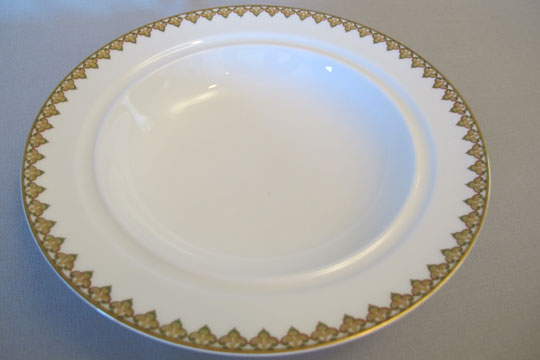 |
 |
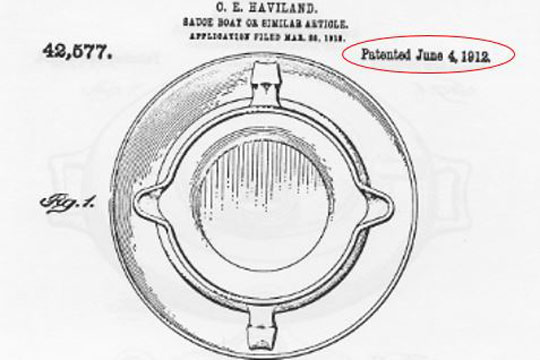 |
| This bowl has an indentation around its interior that would hold a domed cover. Maybe a pancake plate or a muffin plate with cover. The base is 9 1/8 inches across and 1 3/4 inches tall. The bottom of the dome cover would have to be approximately 6 3/4 inches across to fit. |
The photo above to the left shows a close up of the pattern. The photo above to the right shows a patent for the sauce or gravy boat with attached underplate. The patent is dated 1912. This gives an approximate age to these pieces. Although the maker and decorator marks above could mean that the pieces were made from the late 1800s up to 1931 when Haviland closed, it is more likely that The Monaco pattern was made in the very early 1900s. After World War I ended in 1918, the demand for dinner sets with a serving piece for every purpose declined. |







